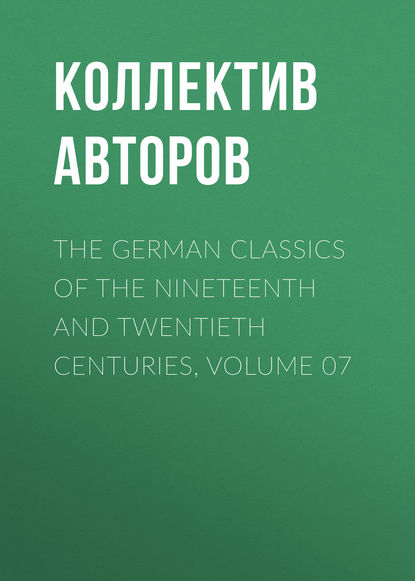По всем вопросам обращайтесь на: info@litportal.ru
(©) 2003-2024.
✖
The German Classics of the Nineteenth and Twentieth Centuries, Volume 07
Настройки чтения
Размер шрифта
Высота строк
Поля
Public opinion is the unorganized way in which what a people wants and thinks is promulgated. That which is actually effective in the State must be so in an organic fashion. In the constitution this is the case. But at all times public opinion has been a great power, and it is particularly so in our time, when the principle of subjective freedom has such importance and significance. What shall now prevail, prevails no longer through force, little through use and custom, but rather through insight and reasons.
Public opinion contains, therefore, the eternal substantial principles of justice, the true content, and the result of the whole constitution, legislation, and the universal condition in general. The form underlying public opinion is sound common sense, which is a fundamental ethical principle winding its way through everything, in spite of prepossessions. But when this inner character is formulated in the shape of general propositions, partly for their own sake, partly for the purpose of actual reasoning about events, institutions, relations, and the recognized wants of the State, there appears also the whole character of accidental opinion, with its ignorance and perversity, its false knowledge and incorrect judgment.
It is therefore not to be regarded as merely a difference in subjective opinion when it is asserted on the one hand—
"Vox populi, vox dei";
and on the other (in Ariosto, for instance)—[2 - Or in Goethe:"Zuschlagen kann die Masse,Da ist sie respektabel;Urteilen gelingt ihr miserabel."]
"Che'l Volgare ignorante ogn' un riprenda
E parli piü di quel che meno intenda."
Both sides co-exist in public opinion. Since truth and endless error are so directly united in it, neither one nor the other side is truly in earnest. Which one is in earnest, is difficult to decide—difficult, indeed, if one confines oneself to the direct expression of public opinion. But as the substantial principle is the inner character of public opinion, this alone is its truly earnest aspect; yet this insight cannot be obtained from public opinion itself, for a substantial principle can only be apprehended apart from public opinion and by a consideration of its own nature. No matter with what passion an opinion is invested, no matter with what earnestness a view is asserted, attacked, and defended, this is no criterion of its real essence. And least of all could public opinion be made to see that its seriousness is nothing serious at all.
A great mind has publicly raised the question whether it is permissible to deceive a people. The answer is that a people will not permit itself to be deceived concerning its substantial basis, the essence, and the definite character of its spirit, but it deceives itself about the way in which it knows this, and according to which it judges of its acts, events, etc.
Public opinion deserves, therefore, to be esteemed as much as to be despised; to be despised for its concrete consciousness and expression, to be esteemed for its essential fundamental principle, which only shines, more or less dimly, through its concrete expression. Since public opinion possesses within itself no standard of discrimination, no capacity to rise to a recognition of the substantial, independence of it is the first formal condition of any great and rational enterprise (in actuality as well as in science). Anything great and rational is eventually sure to please public opinion, to be espoused by it, and to be made one of its prepossessions.
In public opinion all is false and true, but to discover the truth in it is the business of the great man. The great man of his time is he who expresses the will and the meaning of that time, and then brings it to completion; he acts according to the inner spirit and essence of his time, which he realizes. And he who does not understand how to despise public opinion, as it makes itself heard here and there, will never accomplish anything great.
FREEDOM OF THE PRESS
The freedom of public utterance (of which the press is one means, having advantage over speech in its more extended reach, though inferior to it in vivacity), the gratification of that prickling impulse to express and to have expressed one's opinion, is directly controlled by the police and State laws and regulations, which partly hinder and partly punish its excesses. The indirect guarantee lies in its innocuousness, and this again is mainly based on the rationality of the constitution, the stability of the government, and also on the publicity given to the assemblies of the classes. Another security is offered by the indifference and contempt with which insipid and malicious words are, as a rule, quickly met.
The definition of the freedom of the press as freedom to say and write what one pleases, is parallel to the one of freedom in general, viz., as freedom to do what one pleases. Such views belong to the uneducated crudity and superficiality of naïve thinking. The press, with its infinite variety of content and expression, represents what is most transient, particular, and accidental in human opinion. Beyond the direct incitation to theft, murder, revolt, etc., lies the art of cultivating the expression which in itself seems general and indefinite enough, but which, in a measure, conceals a perfectly definite meaning. Such expressions are partly responsible for consequences of which, since they are not actually expressed, one is never sure how far they are contained in the utterances and really follow from them. It is this indefiniteness of the content and form of the press which prevents the laws governing it from assuming that precision which one demands of laws. Thus the extreme subjectivity of the wrong, injury, and crime committed by the press, causes the decision and sentence to be equally subjective. The laws are not only indefinite, but the press can, by the skill and subtlety of its expressions, evade them, or criticise the judgment of the court as wholly arbitrary. Furthermore, if the utterance of the press is treated as an offensive deed, one may retort that it is not a deed at all, but only an opinion, a thought, a mere saying. Consequently, impunity is expected for opinions and words, because they are merely subjective, trivial, and insignificant, and, in the same breath, great respect and esteem is demanded for these opinions and words—for the opinions, because they are mine and my mental property, and for the words, because they are the free expression and use of that property. And yet the basic principle remains that injury to the honor of individuals generally, abuse, libel, contemptuous caricaturing of the government, its officers and officials, especially the person of the prince, defiance of the laws, incitement to revolt, etc., are all offenses and crimes of different grades.
However, the peculiar and dangerous effect of these acts for the individuals, the community, and the State depends upon the nature of the soil on which they are committed, just as a spark, if thrown upon a heap of gunpowder, has a much more dangerous result than if thrown on the mere ground, where it vanishes and leaves no trace. But, on the whole, a good many such acts, though punishable by law, may come under a certain kind of nemesis which internal impotence is forced to bring about. In entering upon opposition to the superior talents and virtues, by which impotence feels oppressed, it comes to a realization of its inferiority and to a consciousness of its own nothingness, and the nemesis, even when bad and odious, is, by treating it with contempt, rendered ineffectual. Like the public, which forms a circle for such activity, it is confined to a harmless malicious joy, and to a condemnation which reflects upon itself.
MEANING OF WAR
There is an ethical element in war. It must not be regarded as an absolute ill, or as merely an external calamity which is accidentally based upon the passions of despotic individuals or nations, upon acts of injustice, and, in general, upon what ought not to be. The recognition of the finite, such as property and life, as accidental, is necessary. This necessity is at first wont to appear under the form of a force of nature, for all things finite are mortal and transient. In the ethical order, in the State, however, nature is robbed of its force, and the necessity is exalted to a work of freedom, to an ethical law. The transient and negative nature of all things is transformed in the State into an expression of the ethical will. War, often painted by edifying speech as a state in which the vanity of temporal things is demonstrated, now becomes an element whereby the ideal character of the particular receives its right and reality. War has the deep meaning that by it the ethical health of the nations is preserved and their finite aims uprooted. And as the winds which sweep over the ocean prevent the decay that would result from its perpetual calm, so war protects the people from the corruption which an everlasting peace would bring upon it. History shows phases which illustrate how successful wars have checked internal unrest and have strengthened the entire stability of the State.
In peace, civic life becomes more extended, every sphere is hedged in and grows immobile, and at last all men stagnate, their particular nature becoming more and more hardened and ossified. Only in the unity of a body is health, and, where the organs become stiff, there is death. Eternal peace is often demanded as an ideal toward which mankind should move. Thus Kant proposed an alliance of princes, which should settle the controversies of States, and the Holy Alliance probably aspired to be an institution of this kind. The State, however, is individual, and in individuality negation is essentially contained. A number of States may constitute themselves into a family, but this confederation, as an individuality, must create an opposition and so beget an enemy. Not only do nations issue forth invigorated from their wars, but those nations torn by internal strife win peace at home as a result of war abroad. War indeed causes insecurity in property, but this real insecurity is only a necessary commotion. From the pulpits much is preached concerning the insecurity, vanity, and instability of temporal things, and yet every one, though he may be touched by his own words, thinks that he, at least, will manage to hold on to his possessions. Let the insecurity finally come, in the form of Hussars with glistening sabres, and show its earnest activity, and that touching edification which foresaw all this now turns upon the enemy with curses. In spite of this, wars will break out whenever necessity demands them; but the seeds spring up anew, and speech is silenced before the grave repetitions of history.
The military class is the class of universality. The defense of the State is its privilege, and its duty is to realize the ideality contained in it, which consists in self-sacrifice. There are different kinds of bravery. The courage of the animal, or the robber, the bravery which arises from a sense of honor, the chivalrous bravery, are not yet the true forms of it. In civilized nations true bravery consists in the readiness to give oneself wholly to the service of the State, so that the individual counts but as one among many. Not personal valor, but the important aspect of it, lies in self-subordination to the universal cause.
To risk one's life is indeed something more than mere fear of death, but this is only negative; only a positive character—an aim and content—gives meaning to bravery. Robbers and murderers in the pursuit of crime, adventurers in the search of their fanciful objects, etc., also possess courage, and do not fear death. The principle of the modern world—the power of thought and of the universal—has given to bravery a higher form; the higher form causes the expression of bravery to appear more mechanical. The brave deeds are not the deeds of any particular person, but those of the members of a whole. And, again, since hostility is directed, not against separate individuals, but against a hostile whole, personal valor appears as impersonal. This principle it is which has caused the invention of the gun; it is not a chance invention that has brought about the change of the mere personal form of bravery into the more abstract.
INTERNATIONAL RELATIONS
Just as the individual is not a real person unless related to other persons, so the State is no real individuality unless related to other States. The legitimate power of a State, and more especially its princely power, is, from the point of view of its foreign relations, a wholly internal affair. A State shall, therefore, not interfere with the internal affairs of another State. On the other hand, for a complete State, it is essential that it be recognized by others; but this recognition demands as a guarantee that it shall recognize those States which recognize it, and shall respect their independence. Hence its internal affairs cannot be a matter of indifference to them.
When Napoleon, before the peace of Campoformio, said, "The French Republic requires recognition as little as the sun needs to be recognized," his words suggest nothing but the strength of existence, which already carries with it the guarantee of recognition, without needing to be expressed.
When the particular wills of the State can come to no agreement their controversy can be decided only by war. What offense shall be regarded as a breach of a treaty, or as a violation of respect and honor, must remain indefinite, since many and various injuries can easily accrue from the wide range of the interests of the States and from the complex relations of their citizens. The State may identify its infinitude and honor with every one of its single aspects. And if a State, as a strong individuality, has experienced an unduly protracted internal rest, it will naturally be more inclined to irritability, in order to find an occasion and field for intense activity.
The nations of Europe form a family according to the universal principle of their legislation, their ethical code, and their civilization. But the relation among States fluctuates, and no judge exists to adjust their differences. The higher judge is the universal and absolute Spirit alone—the World-Spirit.
The relation of one particular State to another presents, on the largest possible scale, the most shifting play of individual passions, interests, aims, talents, virtues, power, injustice, vice, and mere external chance. It is a play in which even the ethical whole, the independence of the State, is exposed to accident. The principles which control the many national spirits are limited. Each nation as an existing individuality is guided by its particular principles, and only as a particular individuality can each national spirit win objectivity and self-consciousness; but the fortunes and deeds of States in their relation to one another reveal the dialectic of the finite nature of these spirits. Out of this dialectic rises the universal Spirit, the unlimited World-Spirit, pronouncing its judgment—and its judgment is the highest—upon the finite nations of the world's history; for the history of the world is the world's court of justice.
INTRODUCTION TO THE PHILOSOPHY OF ART (1820-21)
BY GEORG WILHELM FRIEDRICH HEGEL
TRANSLATED BY J. LOEWENBERG, PH.D. Assistant in Philosophy, Harvard University
THE MEANING OF ART
The appropriate expression for our subject is the "Philosophy of Art," or, more precisely, the "Philosophy of Fine Arts." By this expression we wish to exclude the beauty of nature. In common life we are in the habit of speaking of beautiful color, a beautiful sky, a beautiful river, beautiful flowers, beautiful animals, and beautiful human beings. But quite aside from the question, which we wish not to discuss here, how far beauty may be predicated of such objects, or how far natural beauty may be placed side by side with artistic beauty, we must begin by maintaining that artistic beauty is higher than the beauty of nature. For the beauty of art is beauty born—and born again—of the spirit. And as spirit and its products stand higher than nature and its phenomena, by so much the beauty that resides in art is superior to the beauty of nature.
To say that spirit and artistic beauty stand higher than natural beauty, is to say very little, for "higher" is a very indefinite expression, which states the difference between them as quantitative and external. The "higher" quality of spirit and of artistic beauty does not at all stand in a merely relative position to nature. Spirit only is the true essence and content of the world, so that whatever is beautiful is truly beautiful only when it partakes of this higher essence and is produced by it. In this sense natural beauty appears only as a reflection of the beauty that belongs to spirit; it is an imperfect and incomplete expression of the spiritual substance.
Confining ourselves to artistic beauty, we must first consider certain difficulties. The first that suggests itself is the question whether art is at all worthy of a philosophic treatment. To be sure, art and beauty pervade, like a kindly genius, all the affairs of life, and joyously adorn all its inner and outer phases, softening the gravity and the burden of actual existence, furnishing pleasure for idle moments, and, where it can accomplish nothing positive, driving evil away by occupying its place. Yet, although art wins its way everywhere with its pleasing forms, from the crude adornment of the savages to the splendor of the temple with its marvelous wealth of decoration, art itself appears to fall outside the real aims of life. And though the creations of art cannot be said to be directly disadvantageous to the serious purposes of life, nay, on occasion actually further them by holding evil at bay, on the whole, art belongs to the relaxation and leisure of the mind, while the substantial interests of life demand its exertion. At any rate, such a view renders art a superfluity, though the tender and emotional influence which is wrought upon the mind by occupation with art is not thought necessarily detrimental, because effeminate.
There are others, again, who, though acknowledging art to be a luxury, have thought it necessary to defend it by pointing to the practical necessities of the fine arts and to the relation they bear to morality and piety. Very serious aims have been ascribed to art. Art has been recommended as a mediator between reason and sensuousness, between inclination and duty, as the reconcilor of all these elements constantly warring with one another. But it must be said that, by making art serve two masters, it is not rendered thereby more worthy of a philosophic treatment. Instead of being an end in itself, art is degraded into a means of appealing to higher aims, on the one hand, and to frivolity and idleness on the other.
Art considered as means offers another difficulty which springs from its form. Granting that art can be subordinated to serious aims and that the results which it thus produces will be significant, still the means used by art is deception, for beauty is appearance, its form is its life; and one must admit that a true and real purpose should not be achieved through deception. Even if a good end is thus, now and then, attained by art its success is rather limited, and even then deception cannot be recommended as a worthy means; for the means should be adequate to the dignity of the end, and truth can be produced by truth alone and not by deception and semblance.
It may thus appear as if art were not worthy of philosophic consideration because it is supposed to be merely a pleasing pastime; even when it pursues more serious aims it does not correspond with their nature. On the whole, it is conceived to serve both grave and light interests, achieving its results by means of deception and semblance.
As for the worthiness of art to be philosophically considered, it is indeed true that art can be used as a casual amusement, furnishing enjoyment and pleasure, decorating our surroundings, lending grace to the external conditions of life, and giving prominence to other objects through ornamentation. Art thus employed is indeed not an independent or free, but rather a subservient art. That art might serve other purposes and still retain its pleasure-giving function, is a relation which it has in common with thought. For science, too, in the hands of the servile understanding is used for finite ends and accidental means, and is thus not self-sufficient, but is determined by outer objects and circumstances. On the other hand, science can emancipate itself from such service and can rise in free independence to the pursuit of truth, in which the realization of its own aims is its proper function.
Art is not genuine art until it has thus liberated itself. It fulfils its highest task when it has joined the same sphere with religion and philosophy and has become a certain mode of bringing to consciousness and expression the divine meaning of things, the deepest interests of mankind, and the most universal truths of the spirit. Into works of art the nations have wrought their most profound ideas and aspirations. Fine Art often constitutes the key, and with many nations it is the only key, to an understanding of their wisdom and religion. This character art has in common with religion and philosophy. Art's peculiar feature, however, consists in its ability to represent in sensuous form even the highest ideas, bringing them thus nearer to the character of natural phenomena, to the senses, and to feeling. It is the height of a supra-sensuous world into which thought reaches, but it always appears to immediate consciousness and to present experience as an alien beyond. Through the power of philosophic thinking we are able to soar above what is merely here, above sensuous and finite experience. But spirit can heal the breach between the supra-sensuous and the sensuous brought on by its own advance; it produces out of itself the world of fine art as the first reconciling medium between what is merely external, sensuous, and transient, and the world of pure thought, between nature with its finite reality and the infinite freedom of philosophic reason.
Concerning the unworthiness of art because of its character as appearance and deception, it must be admitted that such criticism would not be without justice, if appearance could be said to be equivalent to falsehood and thus to something that ought not to be. Appearance is essential to reality; truth could not be, did it not shine through appearance. Therefore not appearance in general can be objected to, but merely the particular kind of appearance through which art seeks to portray truth. To charge the appearance in which art chooses to embody its ideas as deception, receives meaning only by comparison with the external world of phenomena and its immediate materiality, as well as with the inner world of sensations and feelings. To these two worlds we are wont, in our empirical work-a-day life, to attribute the value of actuality, reality, and truth, in contrast to art, which is supposed to be lacking such reality and truth. But, in fact, it is just the whole sphere of the empirical inner and outer world that is not the world of true reality; indeed it may be called a mere show and a cruel deception in a far stricter sense than in the case of art. Only beyond the immediacy of sense and of external objects is genuine reality to be found. Truly real is but the fundamental essence and the underlying substance of nature and of spirit, and the universal element in nature and in spirit is precisely what art accentuates and makes visible. This essence of reality appears also in the common outer and inner world, but it appears in the form of a chaos of contingencies, distorted by the immediateness of sense perception, and by the capriciousness of conditions, events, characters, etc. Art frees the true meaning of appearances from the show and deception of this bad and transient world, and invests it with a higher reality, born of the spirit. Thus, far removed from being mere appearances, the products of art have a higher reality and a more genuine being than the things of ordinary life.
THE CONTENT AND IDEAL OF ART
The content of art is spiritual, and its form is sensuous; both sides art has to reconcile into a united whole. The first requirement is that the content, which art is to represent, must be worthy of artistic representation; otherwise we obtain only a bad unity, since a content not capable of artistic treatment is made to take on an artistic form, and a matter prosaic in itself is forced into a form quite opposed to its inherent nature.
The second requirement demands of the content of art that it shall be no abstraction. By this is not meant that it must be concrete, as the sensuous is alleged to be concrete in contrast to everything spiritual and intellectual. For everything that is genuinely true, in the realm of thought as well as in the domain of nature, is concrete, and has, in spite of universality, nevertheless, a particular and subjective character. By saying, for example, that God is simply One, the Supreme Being as such, we express thereby nothing but a lifeless abstraction of an understanding devoid of reason. Such a God, as indeed he is not conceived in his concrete truth, can furnish no content for art, least of all for plastic art. Thus the Jews and the Turks have not been able to represent their God, who is still more abstract, in the positive manner in which the Christians have represented theirs. For in Christianity God is conceived in his truth, and therefore concrete, as a person, as a subject, and, more precisely still, as Spirit. What he is as spirit appears to the religious consciousness as a Trinity of persons, which at the same time is One. Here the essence of God is the reconciled unity of universality and particularity, such unity alone being concrete. Hence, as a content in order to be true must be concrete in this sense, art demands the same concreteness; because a mere abstract idea, or an abstract universal, cannot manifest itself in a particular and sensuous unified form.
If a true and therefore concrete content is to have its adequate sensuous form and shape, this sensuous form must—this being the third requirement—also be something individual, completely concrete, and one. The nature of concreteness belonging to both the content and the representation of art, is precisely the point in which both can coincide and correspond to each other. The natural shape of the human body, for example, is a sensuous concrete object, which is perfectly adequate to represent the spiritual in its concreteness; the view should therefore be abandoned that an existing object from the external world is accidentally chosen by art to express a spiritual idea. Art does not seize upon this or that form either because it simply finds it or because it can find no other, but the concrete spiritual content itself carries with it the element of external, real, yes, even sensuous, representation. And this is the reason why a sensuous concrete object, which bears the impress of an essentially spiritual content, addresses itself to the inner eye; the outward shape whereby the content is rendered visible and imaginable aims at an existence only in our heart and mind. For this reason alone are content and artistic shape harmoniously wrought. The mere sensuously concrete external nature as such has not this purpose for its only origin. The gay and variegated plumage of the birds shines unseen, and their song dies away unheard; the torch-thistle which blossoms only for a night withers without having been admired in the wilds of southern forests; and these forests, groves of the most beautiful and luxuriant vegetation, with the most odorous and fragrant perfumes, perish and waste, no more enjoyed. The work of art is not so unconsciously self-immersed, but it is essentially a question, an address to the responsive soul, an appeal to the heart and to the mind.
Although the sensuous form in which art clothes its content is not accidental, yet it is not the highest form whereby the spiritually concrete may be grasped. A higher mode than representation through a sensuous form, is thought. True and rational thinking, though in a relative sense abstract, must not be one-sided, but concrete. How far a definite content can be adequately treated by art and how far it needs, according to its nature, a higher and more spiritual form, is a distinction which we see at once if, for example, the Greek gods are compared with God as conceived in accordance with Christian notions. The Greek god is not abstract but individual, closely related to the natural human form. The Christian God is also a concrete personality, but he is pure spiritually, and can be known only as spirit and in spirit. His sphere of existence is therefore essentially inner knowledge, and not the outer natural shape through which he can be represented but imperfectly and not in the whole depth of his essence.
But the task of art is to represent a spiritual idea to direct contemplation in sensuous form, and not in the form of thought or of pure spirituality. The value and dignity of such representation lies in the correspondence and unity of the two sides, of the spiritual content and its sensuous embodiment, so that the perfection and excellency of art must depend upon the grade of inner harmony and union with which the spiritual idea and the sensuous form interpenetrate.
The requirement of the conformity of spiritual idea and sensuous form might at first be interpreted as meaning that any idea whatever would suffice, so long as the concrete form represented this idea and no other. Such a view, however, would confound the ideal of art with mere correctness, which consists in the expression of any meaning in its appropriate form. The artistic ideal is not to be thus understood. For any content whatever is capable, according to the standard of its own nature, of adequate representation, but yet it does not for that reason lay claim to artistic beauty in the ideal sense. Judged by the standard of ideal beauty, even such correct representation will be defective. In this connection we may remark that the defects of a work of art are not to be considered simply as always due to the incapacity of the artist; defectiveness of form has also its root in defectiveness of content. Thus, for instance, the Chinese, Indians, Egyptians, in their artistic objects, their representations of the gods, and their idols, adhered to formlessness, or to a vague and inarticulate form, and were not able to arrive at genuine beauty, because their mythological ideas, the content and conception of their works of art, were as yet vague and obscure. The more perfect in form works of art are, the more profound is the inner truth of their content and thought. And it is not merely a question of the greater or lesser skill with which the objects of external nature are studied and copied, for, in certain stages of artistic consciousness and artistic activity, the misrepresentation and distortion of natural objects are not unintentional technical inexpertness and incapacity, but conscious alteration, which depends upon the content that is in consciousness, and is, in fact, demanded by it. We may thus speak of imperfect art, which, in its own proper sphere, may be quite perfect both technically and in other respects. When compared with the highest idea and ideal of art, it is indeed defective. In the highest art alone are the idea and its representation in perfect congruity, because the sensuous form of the idea is in itself the adequate form, and because the content, which that form embodies, is itself a genuine content.
The higher truth of art consists, then, in the spiritual having attained a sensuous form adequate to its essence. And this also furnishes the principle of division for the philosophy of art. For the Spirit, before it wins the true meaning of its absolute essence, has to develop through a series of stages which constitute its very life. To this universal evolution there corresponds a development of the phases of art, under the form of which the Spirit—as artist—attains to a comprehension of its own meaning.
This evolution within the spirit of art has two sides. The development is, in the first place, a spiritual and universal one, in so far as a gradual series of definite conceptions of the universe—of nature, man, and God—finds artistic representation. In the second place, this universal development of art, embodying itself in sensuous form, determines definite modes of artistic expression and a totality of necessary distinctions within the sphere of art. These constitute the particular arts.
We have now to consider three definite relations of the spiritual idea to its sensuous expression.
SYMBOLIC ART

















